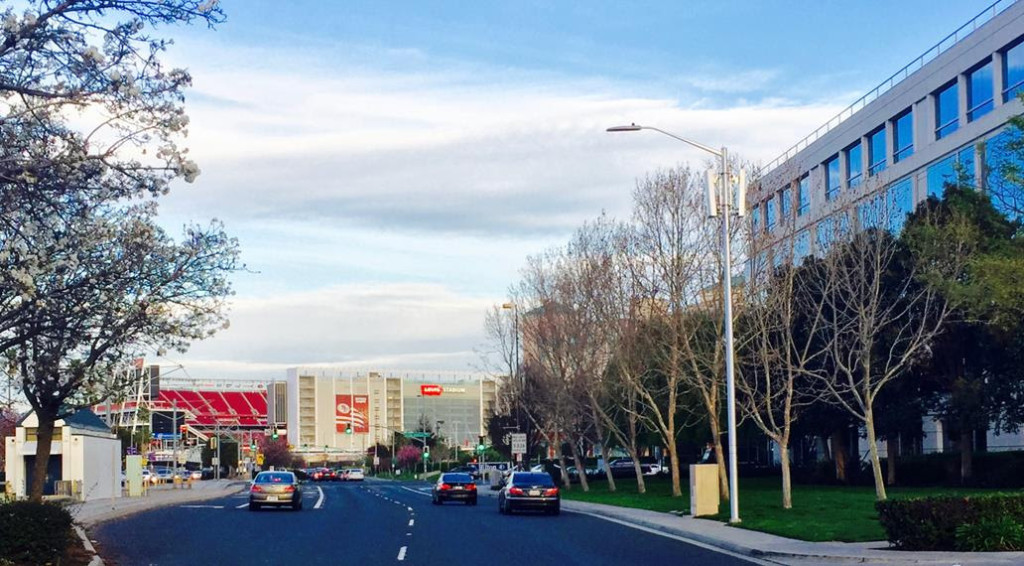Outdoor DAS Successfully Supports Users in Areas Outside of Levi’s Stadium Before, During and After the Big Game
The performance of the distributed antenna system (DAS) that successfully carried unprecedented traffic loads during Super Bowl 50 has received its share of industry attention and applause.
Editor’s note: This is the final of a four-part series focusing on various elements of the successful DGP-built DAS that supported record-breaking traffic across the dozens of acres allocated to Super Bowl 50 festivities. For past articles, visit dgpdas.com.
Above: Note the light pole in the foreground, on the right? That’s one of the public oDAS nodes that discreetly played its part to support massive game day traffic in Santa Clara.
The performance of the distributed antenna system (DAS) that successfully carried unprecedented traffic loads during Super Bowl 50 has received its share of industry attention and applause. The statistics from all seating areas, concourses and even from deep within the stadium were astonishing and are likely to establish new norms for network management.
But support for cellular users was tremendous outside the stadium as well, with system performance right in line with the record-breaking stats delivered inside the stadium.
The admittedly less glamorous, but equally important, areas adjacent to the arena, like parking lots and pre-game spaces, were also designed, built and managed by DAS Group Professionals (DGP). In this case DGP’s clients were the City of Santa Clara and Silicon Valley Power.
In late 2014, DGP was hired by the two public agencies to design, build and manage a distributed antenna system (DAS) that would eventually extend across that city but that would begin in the areas around Levi’s Stadium, Great America and the convention center. The specifics of the first phase launch were firm: in time for Super Bowl 50 and for use by any of the cellular carriers who signed on.
With less than a year to work, time for the project was short, and everyone involved knew it. However, some project elements, like the ability to use existing infrastructure such as light poles and power supply, were expected to enable the project to move swiftly. The vast majority of the work happened in the six months between when the first carrier signed on in July, and when real-time testing began in early January.
Things got complicated along the way when the existing light poles and other physical infrastructure, including power supply, was judged insufficient for the project. The solution – updating the infrastructure – would have been easy, but the new light poles arrived three months late, in mid-December.
“That was a huge challenge, because the nodes couldn’t be put in place until then. Remember, they’re mounted to the poles. That left us a month to install everything and get it tested. It was extremely tight,” explains DGP Project Manager Dawn Love.
Careful coordination with multiple contractors and carriers is always part of DGP’s work, but in this case the short timelines made it especially critical. “Because of the limited amount of time for construction, Verizon had to start building out their head end lease area before we were done with our head end construction,” explains Love. “The construction managers had to coordinate closely. On some days there were three different crews out working at the same time in the small head-end compound.”
DGP had to also work carefully to successfully integrate with the stadium DAS, SVP, and the carrier’s networks. “The choreography of so many players was challenging, but because everyone was laser-focused on the same goal it worked. The teamwork was really impressive. Everyone’s crews were professional, dedicated and collaborative. It was exciting to witness,” says DGP Vice President Vince Gamick.
In the end, performance was the only measure of success, and the system passed with flying colors – by all measures.
“Surprises, complications, all of that doesn’t matter in the end,” says Gamick. “It’s whether calls and data are supported. Unless the cellular customer is successful, every logistical success and every bit of engineering brilliance is irrelevant.”
As for the future? The initial build included 15 nodes and one carrier. DGP and its client expect the coming year to include more nodes and additional carriers. The city-wide build is still a reality, and with the challenges that the first phase brought, the team is optimistic about the speed with which it can be completed. “We overcame so much for the first part of this job, and the City and Silicon Valley Power learned so much, that I think the next phases are going be smooth sailing,” predicts Gamick.
For more information about the City and SVP project, see our initial news release profiling the project.

